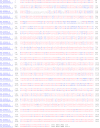The Proteins of Severe Acute Respiratory Syndrome Coronavirus-2 (SARS CoV-2 or n-COV19), the Cause of COVID-19
- PMID: 32447571
- PMCID: PMC7245191
- DOI: 10.1007/s10930-020-09901-4
The Proteins of Severe Acute Respiratory Syndrome Coronavirus-2 (SARS CoV-2 or n-COV19), the Cause of COVID-19
Abstract
The devastating effects of the recent global pandemic (termed COVID-19 for "coronavirus disease 2019") caused by the severe acute respiratory syndrome coronavirus-2 (SARS CoV-2) are paramount with new cases and deaths growing at an exponential rate. In order to provide a better understanding of SARS CoV-2, this article will review the proteins found in the SARS CoV-2 that caused this global pandemic.
Keywords: Proteins; SARS CoV-2; Virus.
Figures


























References
Publication types
MeSH terms
Substances
LinkOut - more resources
Full Text Sources
Other Literature Sources
Miscellaneous

